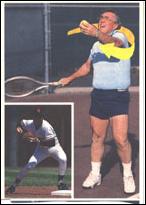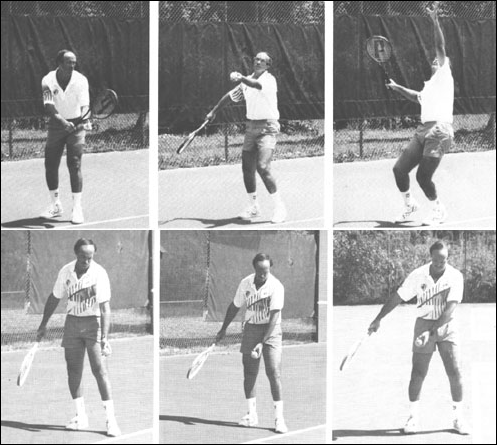Revolutionary Tennis |
||
Tennis Instruction That Makes Sense |
||
”TONTERĶAS! or WHY YOU HAVE TOSS ISSUES © Mark Papas mark@revolutionarytennis.com
Who wants to tell Vic a fielder's technique "brings both arms back and up as he coils his upper body for the throw" because he brings the glove hand back to his throwing hand to pull the ball out of the glove and not vice versa? Who wants to tell Vic when a baseball player cocks his arm to throw (not merely lifting it up with the glove hand to grab the ball) his catching arm goes out in front of him? Vic continues. "Yet that is exactly what most tennis players do when they serve. Instead of naturally bringing both arms back and up together as they rotate their shoulders, they toss the ball with that arm pointing straight out in front of them and attempt to serve just by cocking the racquet arm, with no shoulder rotation." It is ironic Vic addresses the lack of shoulder rotation considering the service stance In-Conflict he and others advise contributes to this. You lack shoulder rotation if you toss from the service stance In-Conflict because you are facing the net and are not turned like your lower body. But if you begin with the Simple Service Stance you are turned (away from the net) and will have shoulder rotation. BTW, how "natural" is it to bring both arms back and up together as you rotate the shoulders unless you're reaching back with both hands? Vic's ideas address a perceived lack of shoulder rotation in students' serves, and he thinks said shoulder rotation will occur only when both arms go down and back and up together [to rotate the shoulders]. Revolutionary tennis shows how shoulder "rotation" occurs without dragging the toss arm down, back, up, and around. Pros, world class players, college guys and girls, and good juniors do this all the time. And so can you. A student needs to learn that/how the back shoulder rotates back while the toss arm moves in an opposite direction. This is accomplished from either service stance but is more easily done starting with the Simple Service Stance as opposed to the one In-Conflict (less to do to start with). The fact missing from the usual analysis is how the toss arm and back shoulder go in opposite directions. Sure it's known you toss and close/turn the shoulders but what is not stated is the differentiation of toss arm to back shoulder. In this way all of us manage to engage shoulder rotation for our serve without "bringing both arms back and up together." The late great Pancho Gonzalez had an undulating rotate-back, rotate-forward lazy-man-looking style similar to a baseball infielder easily pulling the ball out of the glove and zipping it to first. But Vic never understood that Pancho first re-turned from the stance In-Conflict and that his toss arm worked its way forward to toss the ball straight up, it wasn't going back to his racket arm to then go forward in an arcing motion. The ball arcs forward because the toss arm is moving forward and the body weight is shifting, not because Pancho is tossing it on that arc purposely. And while Pancho's toss was on the lower side and I agree you don't need to toss the ball nearly as high as you see in some pros, Pancho tossed high enough to have time between the toss and hit, his success had little to do with hitting it at the peak of the toss. And let's not forget the zip he had on the forward swing, that is the gun in his arm, which again has nothing to do with the toss or its height. I don't see both arms going backwards and remaining back behind the tennis pro before the forward swing. Do you? Edberg did this, but he is the exception. I'm sure there are others, but they are few. More follows with this toss arm misunderstanding..
If we asked Groppel to throw his racket over the net from the service stance In-Conflict (top left photo above) could he throw it while facing the net or would he turn his shoulders away first to match his lower body's angle (middle photo top above)? The answer is obvious, the student must accommodate. How will the student succeed to optimize trunk rotation, even though it is more difficult to bring the toss arm down and back toward the rear pocket? She or he will just have to accommodate. Accommodation is the socialist step-child from the stance In-Conflict. A pro, like you, is taught the stance In-Conflict, but the athlete breaks free from arbitration and expresses him/herself in pure terms. Instead the Groppels and Bradens want to force you into a mold of their own design. The tennis pro re-adjusts from the conflict to a neutral position before the actual "serve" takes place. If you follow baseball this is exactly what a pitcher does when he pitches from the stretch and not the full windup. He is turned sideways on the mound, and when he's looking at the catcher for the sign often his upper body faces the catcher, hand on one knee, while the lower body faces the third base side. His next move, once he has the sign, is to reconcile both halves of his body, his upper body re-turns to face third like his lower body, and he realigns up. Next he checks the runner at the bag and starts the forward pitching motion. The tennis pro turns to close his shoulder line in order to serve, the toss arm no longer hangs out towards the service box but first (re)turns back in the process. This is misunderstood by the tennis personalities as the toss arm going back. Furthermore, the toss arm can not move that much in the direction forward toward the net because you need to remain turned during the swing and not open prematurely (explained later during the forward swing portion). Professional tennis players turn their back shoulder away from the tossing arm as the toss arm lifts the ball "out in front." You can do this with less effort and complication if you start from the Simple Service Stance instead of the one In-Conflict. You will be able to "turn the shoulders" and your toss arm will be a simple straight down-and-up motion you have been denied all these years. Why add more moving parts and make the serve harder than it already is? You know what they say: Those who can, do, and those who can't, teach. And I'm well aware I teach, thank you very much. But let's add one to this time honored axiom: Those who can't teach do sports science. Come on! [photos: Vic Braden, Dom Furore/TENNIS magazine, August, 1989; infielder inset Otto Greule Jr./ALLSPORT USA.] |
||
 Vic Braden invokes a baseball player's fielding technique to help you serve in TENNIS magazine, August 1989, "Shattering Your Myths About The Serve." Vic tries to pass of as "myths" tossing the ball high, the backscratch position, and snapping the wrist. The part relevant for us here is captioned "Bring Both Arms Back And Up On The Ball Toss." Vic asks, "Did you ever see a baseball fielder throw a ball? He brings both arms back and up as he coils his upper body for the throw (small photo at left). He doesn't point his catching arm out in front of him while cocking his throwing arm." By his own admission Vic was not much of a tennis player, and now I doubt he ever played baseball, as I did and I'm sure lots of you readers.
Vic Braden invokes a baseball player's fielding technique to help you serve in TENNIS magazine, August 1989, "Shattering Your Myths About The Serve." Vic tries to pass of as "myths" tossing the ball high, the backscratch position, and snapping the wrist. The part relevant for us here is captioned "Bring Both Arms Back And Up On The Ball Toss." Vic asks, "Did you ever see a baseball fielder throw a ball? He brings both arms back and up as he coils his upper body for the throw (small photo at left). He doesn't point his catching arm out in front of him while cocking his throwing arm." By his own admission Vic was not much of a tennis player, and now I doubt he ever played baseball, as I did and I'm sure lots of you readers. Jack Groppel's instructional series on how-to tossing motions to maximize body rotation for a more powerful serve unfortunately starts with the flawed assumption that is the service stance In-Conflict (photo upper left). The top three photos on the right, dated July, 1990 from the USPTA's own ADDvantage magazine, teach "proper coordination of front foot and body rotation." The bottom three, from November, 1990, same magazine, illustrate "three basic tossing motions. The motion at the far right, the same used by most touring pros, promotes optimal trunk rotation but is more difficult to learn. Conversely, the motion at the far left tends to limit rotation but is simplest to learn." We go from one that "limit[s] rotation but is simplest to learn" to one that produces "optimal trunk rotation but is more difficult." He says there are 3 ways of bringing the toss arm down: to his front leg, down back to his groin, down back to his rear hip. This is under the heading: "A Toss UP: Any of the basic tossing motions is OK provided the student can accommodate."
Jack Groppel's instructional series on how-to tossing motions to maximize body rotation for a more powerful serve unfortunately starts with the flawed assumption that is the service stance In-Conflict (photo upper left). The top three photos on the right, dated July, 1990 from the USPTA's own ADDvantage magazine, teach "proper coordination of front foot and body rotation." The bottom three, from November, 1990, same magazine, illustrate "three basic tossing motions. The motion at the far right, the same used by most touring pros, promotes optimal trunk rotation but is more difficult to learn. Conversely, the motion at the far left tends to limit rotation but is simplest to learn." We go from one that "limit[s] rotation but is simplest to learn" to one that produces "optimal trunk rotation but is more difficult." He says there are 3 ways of bringing the toss arm down: to his front leg, down back to his groin, down back to his rear hip. This is under the heading: "A Toss UP: Any of the basic tossing motions is OK provided the student can accommodate."